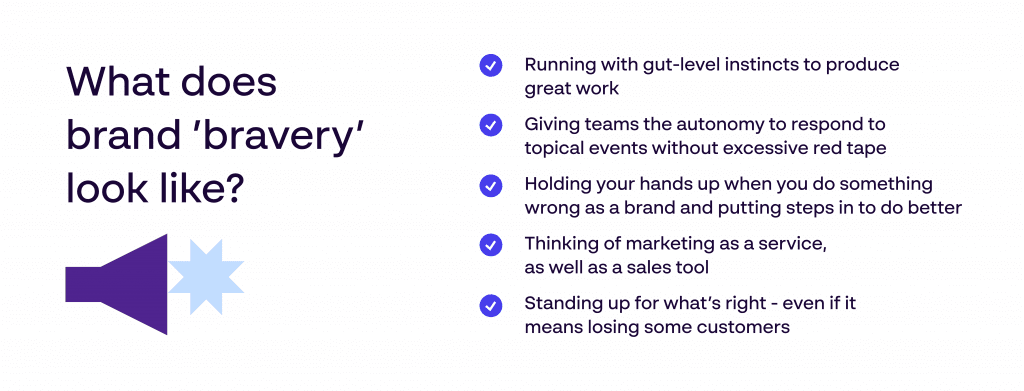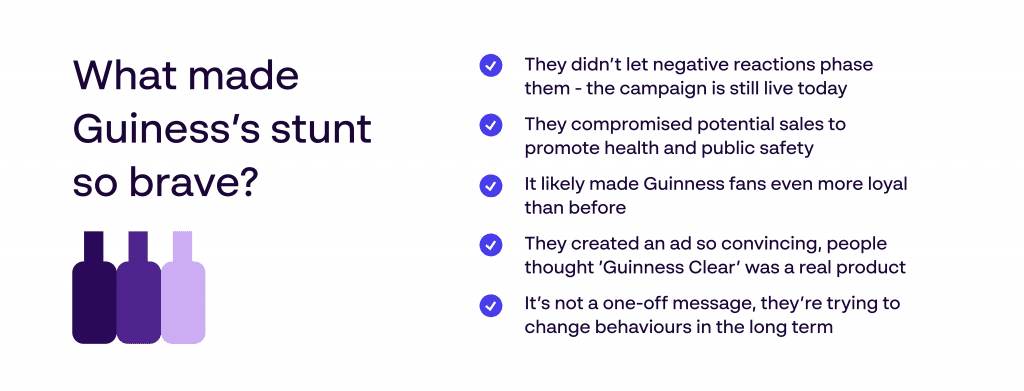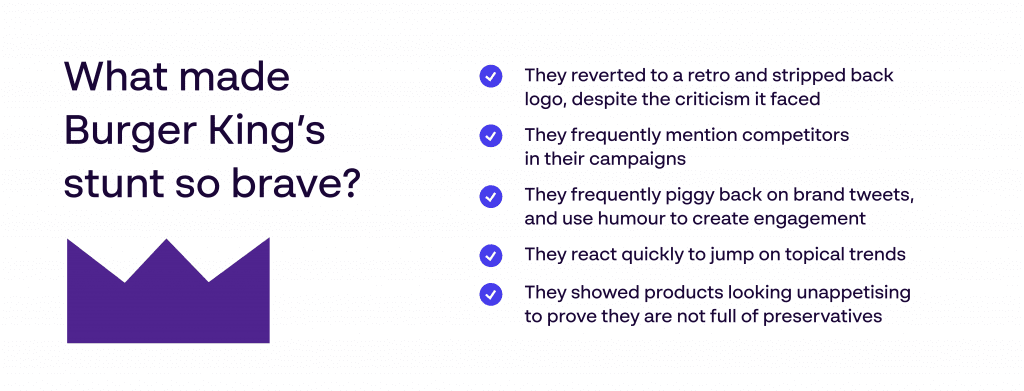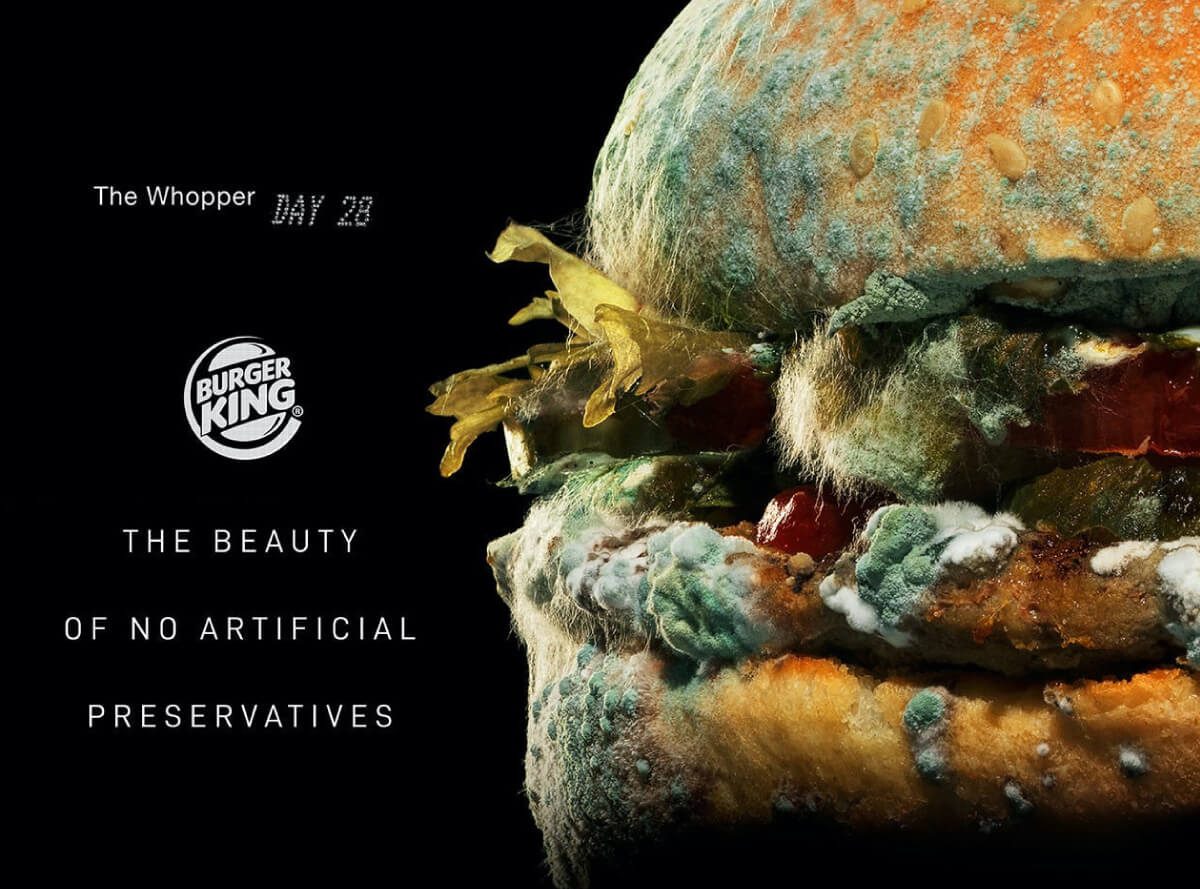When we talk about brands being brave, we don’t mean the ‘running into burning buildings’ kind of brave. We’re talking about a risky move that has the potential to go very well or horribly wrong.
Let’s take a look at the reasons why a brand may choose to do something a little on the edgy side, and at some classic and modern examples of where these have paid off.
Why does the potential payoff outweigh the risk?
Even some of the most established brands in the world can fall into the trap of becoming too comfortable, too predictable or too familiar. They need to be consistent, yes, but never dull.
A move that’s out of the ordinary reawakens an audience to new possibilities and provides them with a fresh perspective or view of the brand. It may reposition them entirely for some or reaffirm what an existing audience already knew.
When this happens, there’s usually a flurry of free PR that follows. And not just from industry news outlets. Brands doing things out of the ordinary usually gain traction on wider social media and content publishing platforms. Understanding the impact on a brand from a business, customer and marketing level is one thing – how the media spins it is another. So teams need to have a plan in place to cover all eventualities.
What does brand bravery mean?
While in more recent times, brand bravery has shaped itself to be more about taking a stand on a particular topic or movement, historically it has involved doing something controversial or irreverent – which doesn’t fit our definition of brave. It would be great if every campaign has a direct positive impact on society, but this would flood the world with inauthentic attempts to make a difference.

Below we’ve selected 4 brands that have made distinctly ‘brave’ moves in their marketing…
Guinness took a risk
Guinness advertising has long been iconic. But back in 2019, they took things to the next level. When Guinness cleverly announced that it was launching ‘Guinness Clear’ in a slot before the Six Nations rugby, they sent Twitter into a frenzy with desperate fans scrambling to find the new drink online.
Of course, many others quickly caught onto the purpose of the ads. Guinness Clear was simply a pint of water. What the drinks giant had done was highlight the need to consume more water in between pints of the black stuff, to reduce overall alcohol consumption for a healthier attitude towards drinking during matches.
The ad was later re-released at Christmas, a time that’s notorious for revellers having more than one too many.
We think out of all the stunts Guinness has pulled, this is the one that sets them apart, and defines them most closely to the term brave. While the concept was lost initially on some people, it eventually got everyone talking and raised awareness of the power of drinking water in between alcohol. Which of course, means buying less Guinness. When a brand prioritises the health and safety of consumers over sales, it’s an unusual and welcome step in the right direction.

Lush turned the light off
While Lush has come under fire in the past for what some have described as “crossing a line” between being a retailer and an advocate for pushing societal issues, the brand seems more than comfortable as a rebellious crusader promoting what’s right.
All the deep and complex issues the handmade cosmetics company manages to address are very impressive, and you’d think that social media would be a great place to amplify the good work you’re doing.
However, back in 2019 Lush made the announcement it was to stop publishing from its UK social media platforms.
Now the reason behind this was due to how the organic algorithm works on Facebook. The Lush team had become frequently frustrated with pouring their heart and soul into their content, only for the social media platform to make it hard for them to reach many people organically.
It’s widely known that Facebook has a much more powerful audience reach when you pay-to-play through their advertising services. But Lush took a stand against the tech giant by calling it quits, and as it turned out it has paid off very well for them.
What the data showed them was that their audience was more engaged on their ‘owned’ platforms. So Lush now communicates via its employees and own platforms, to create richer, more authentic experiences and conversations for its customers.
Regardless of your relationship with Facebook, a global brand turning its back on a huge channel in an act of taking the moral high ground is pretty cool. Think of just how many sales they will have lost from the move. What we’re wondering is how long will they be able to keep it up?

Burger King threw out the rule book
While many of BK’s stunts have been hit and miss, they always garner attention from the media. Whether it’s encouraging customers in Brazil to virtually burn the adverts of its rivals, or highlighting gender disparity in China with its Burger Queen campaign, the Burger King marketing team appear to be working overtime to continually create sometimes regrettable but mostly unforgettable campaigns.

Here are just some of the bold moves the brand has taken…
They launched a Christmas ad in July
When the world realised 2020 wasn’t quite shaping up to be the year we all expected, Burger King jumped in and transformed one of its stores in the U.S. with Christmas decorations. The advert highlights to customers that they’re doing their bit to help wrap up the negative year by bringing the holidays much earlier. We’re not sure how many additional burgers it helped them sell, but it was a nice move nonetheless.
They weighed in on British politics
Driving an iconic red London bus around Westminster (where England’s MPs are based) with a controversial message takes some courage. Burger King’s use of Whopper in this ad not only plays on their product, but it’s also an informal word for a lie in the UK. Make of that what you will.

Credit @stu_bot3000 via Twitter
They showed their burgers growing mould
Who could forget when Burger King removed artificial preservatives from its burger? They boldly left a Whopper to decay over a period of 34 days and then shared the results with the world. While this was met with some criticism of the ad being more for ‘ad people’ than customers, it certainly seemed to get people talking. Regardless of opinions, in a sea of been-done-before creatives, Burger King burst through with this unexpected and insightful concept. We say, bravo.

They undertook their first rebrand in 20 years
Burger King’s new logo took everyone by surprise. If you’re in marketing, you’ll understand just how much a rebrand can cost a company, let alone someone that has signage all over the world. The justification behind the move was that the brand wanted to capture more of its characteristics in its identity, big and bold, playful and irreverent. The retro-inspired logo certainly stirs up nostalgia.

Other examples worth mentioning
Always – Like A Girl campaign
The global personal hygiene company took purpose-driven marketing to a whole new level back in 2014. Always was keen to keep young girls feeling confident through puberty and set out to change perceptions of what it means to ‘be a girl’. They addressed many sexist misconceptions on female abilities all based around the hashtag #LikeAGirl.
The idea stems from phrases that have been wrongly used as derogatory such as “You throw like a girl”. The creatives behind these realigned perceptions, turning any negative preconceptions about the abilities of girls into positive ones.
Read about the incredible results here.
Coca-Cola – One-brand move
Back in 2014, the global drinks brand united 14 of its product family under one aligned campaign. They described the move as “putting the product at the heart of the creative” and it gave them the opportunity to create universal storytelling that would connect consumers from around the world. You can read how it’s benefited the brand here.
While it isn’t bravery in the traditional sense, from the internal and logistical perspective of their marketing teams, it was a big step. And it paid off well in the short-term – although they have recently decided to change tact to unveil an all-new look for Coca-Cola Zero cans to try and set them apart.
Maersk Line – Learning from a mistake
Also in 2014, Maersk Line made a brave move by sharing a photo of a dead whale on their social media channels that was struck by one of their cargo ships. Maersk did not shy away from this unfortunate accident, and instead highlighted it as a signal of their intention to learn more about whale behaviour and adjust their own practices to ensure this can never happen again.
This open, honest discussion captured worldwide attention and engaged many marine experts offering their advice as to how Maersk’s team can avoid these events in future. Taking this bold step allowed them to control the narrative and shape it as a teachable moment – something they will learn from to better their process in future.
The Met Museum – Ignored traditional design rules
The Metropolitan Museum of Art has been a staple institution in society for over 145 years. So when they replaced their logo with one that featured an unusually kerned typeface, it caused a bit of controversy amongst its die-hard fans. When you delve into the reasons behind the move, bringing together serif and sans serif letters to recognise its ability to unify both the classic and the modern, it makes a lot of sense.
Premier League – No Room for Racism Campaign
What started as bringing together footballers to encourage people to report racism in the stadiums has evolved into a long-standing campaign to try and stamp out discrimination in the football industry. The sporting institution came under fire in 2020 when it publicly showed support for the Black Lives Matter movement in the UK. They have since released a statement to say that the support is not in any way political and that it aligns with their objectives of “eradicating racial prejudice wherever it exists”. They have stuck by this and continue their support to this day.
ITV – Mental Wellness Campaign
The television channel used a primetime TV show and ad break to run silent adverts, and encouraging viewers to instead talk to each other about what’s going on in their lives and their minds.
Does it pay to take risks?
Every brand is different, and while taking some of these risks could have gone either way for the mentioned brands, ultimately they stood up, did something different and it paid off. The scale of the risk you take depends on what you’re comfortable with, and how your brand needs to be positioned to the world.
Not taking any risks at all can be greater than taking them to begin with. Producing stale, uninspiring campaigns could leave you looking predictable. It’s always important to weigh up the pros and cons behind any idea, and be prepared for all eventualities should it not go the way you’d hoped.
Finally, ensure that any big move you make is grounded in strategy, controversy or bravery for the sake of it could fall flat if there’s no solid direction and reasoning.
